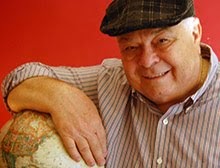 |
| London is a great setting for New Year's (blogautoeurope.com) |
 |
| Ancient Babylon was the first place to celebrate New Year's (ancientoriginal.net) |
Did you know,
for example, that making New Year's resolutions dates as far back as 2600 B.C.
with the Babylonians. Using that as a guide, here are some other Day 1
traditions from around the globe.
Continuing with
all good intentions of resolutions, the most common promises deal with diet,
exercise, bad habits and other issues regarding personal wellness. Much like
making the turn in a round of golf, a new year symbolizes a fresh start, which,
also as in golf when the drive off the tenth tee goes askew, resolutions
typically only last until January 2nd.
 |
| Some folks think a New Year's swim is fun (wikipedia) |
In America
Often the New
Year's Day menu consists of circular shaped cuisine to remind us that the first
day of the year sets the precedent for the upcoming days of the calendar.
 |
| Irish pastries are known as Bannocks (wikipedia) |
Eating any
ring-shaped treat, such as a doughnut, harkens to the idea of "coming full
circle" which represents good fortune.
In Holland , fritters called olie bollen are served,
while the Irish enjoy pastries known as "bannocks" and in India and Pakistan
 |
| The Dutch eat fritters called "olie bollen" (wikipedia) |
There is
frequently a midnight feast in the Philippines
 |
| Spaniards eat twelve grapes at midnight for good luck (Spain info) |
At the stroke of
midnight Spaniards eat twelve grapes to represent each month of the year.
Though a nice tradition, others might prefer to drink their way through the
custom only to suffer the "wrath of grapes" in the morning.
 |
| Greens and black-eyed peas are the food of choice in the South in the United States (wikipedia) |
In the southern United States
 |
| Swiss fireworks are among the best (MySwitzerland.com) |
Meanwhile, the
normally ultra-fastidious Swiss prefer to drop dollops of whipped cream on the
floor and allow them to remain there!
Being the first
day of the year, it is always a good idea to "put your best foot forward."
Thus the superstition goes that the first person, therefore the "first
foot," to cross a threshold after midnight will predict the family fortune
for the coming year.
The "first
foot" tradition has numerous variations, but the people deemed the most
fortunate "first footers" are new brides, new mothers, tall-dark, handsome
men or anyone born on January 1. By the way, "first footers" are also
known as "Lucky Birds."
The key to
activating this superstition to the fullest however, is not to let anything
leave the house on New Year's Day except people.
According to
tradition, don't take out the trash on New Year's Day. Leave anything else you
might want to remove from the house outside the night before. The only option,
if you must take something out, is to replace it by bringing something else
inside in order to maintain balance.
Also, you should
avoid paying bills, breaking anything or shedding tears.
 |
| Wassail is a spicy hot drink in the UK (wikipedia.org) |
Toasting is, of
course, one of the most popular New Year's traditions. In some parts of England
The Scots have
their own version of Wassail which is a spiced "hot pint" that is
traditionally guzzled in honor of each other's prosperity. The toast is also
usually accompanied with a small gift.
Otherwise,
champagne is the toast of choice throughout most of the world.
 |
| In northern regions, swimming in frozen lakes and rivers is considered "fun" (wikipedia) |
On the other
hand, there are a few odd traditions such as running into a body of water in
coastal regions as a means of cleansing or "rebirth."
Some of the more
hardy northern regions of Canada, Scandinavia, the UK, the Netherlands and,
even, the US enjoy a "Polar Bear Plunge" by diving into icy or
semi-frozen bodies of water to raise money for charity.
Since religion
was suppressed in Russia Moscow there are fireworks and a
massive holiday party is televised from Red Square
and decorated trees, which were forbidden until December 26th suddenly make an
appearance during the week leading up to New Year's Eve.
 |
| The French start the year off with mistletoe (wikipedia) |
The day’s
weather forecast for the upcoming year’s harvest is also important in France
New Year's just
wouldn't seem right without noise. Celebrations in the Philippines
 |
| Rajahstan, India lights up the New Year's night (India Today) |
In ancient Thailand , guns were fired to frighten away the demons,
but in China
Today, Italians
let their church bells peal, the Swiss beat drums and North Americans sound
sirens and party horns to bid the old
year farewell.
 |
| Scottish writer Robert Burns published "Auld Lang Syne" (Poetry Foundation) |
And finally, the
song, “Auld Lang Syne,” is sung at the stroke of midnight in almost every
English-speaking country in the world.
Partially
written by Robert Burns in the 1700’s, it was first published in 1796 after
Burns’ death. Early variations of the song were sung prior to 1700, inspiring
Burns to produce the modern version of an old Scottish tune that literally
means “old long ago,” or simply, “the good old days.”
 |
| Fireworks at Edinburgh Castle in Scotland are breathtaking (welcome to scotland) |
And so from the
"good old days" to the hopefully "good new days" of 2018, here's
wishing everyone a Happy and Prosperous New Year!





































